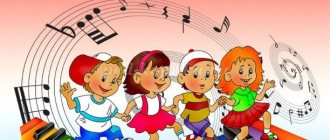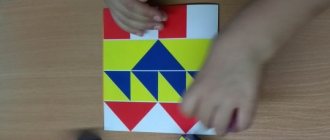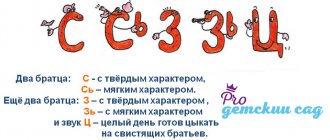Shmakova Elena
Notes of speech therapy classes on production and automation of whistling sounds
Production , automation and differentiation of whistling sounds .
Speech therapy lesson notes.
Lesson 1 . Lesson notes on sound production [C] .
Preparatory stage.
Goal: preparing the articulatory apparatus for producing sound [s] ; formation of a long-lasting directed air stream; an exercise in distinguishing words that sound similar; the ability to determine the presence of the sound [s] in a series of sounds ; development of the function of language analysis and synthesis; nurturing positive motivation in educational activities.
Equipment: pictures: articulation gymnastics for whistling ; image [C] ; hammer for tapping rhythm; toy plane; chest “Breath”
.
Progress of the lesson.
1. Organizational moment.
2. Statement of the purpose of the lesson .
3. Repeating the game to develop fine movements of the hands and fingers.
4. Articulation gymnastics. Exercises aimed at developing tongue mobility. (see art. control for setting sound [s] )
.
5. Games for the development of speech breathing.
• Development of exhalation force
Blowing through a tube. Blowing soap bubbles. Comparison of expiratory duration. Pronouncing the sound [f] (long exhalation, pronouncing the sound [t] (short exhalation)
.
• Development of exhalation force. Developing a smooth and long exhalation. “Dandelions”
“Games for tigers”
– computer technology.
• "Put out the candle"
. Developing an intense intermittent exhalation while pronouncing fuuuuu.
• "The Storm Howls"
. Developing the correct direction of the air stream along the midline of the tongue. Bring a bottle with a narrow neck to your lower lip and blow. If noise appears at the same time, it means that the air stream is directed correctly.
Exercises to develop the ability to form a bow with the lateral edges of the tongue with the upper molars
• “The baby learns to pronounce the sound [i] ”
.
Place the tip of your tongue behind your lower teeth and pronounce the sound [i] . Make sure that the dimple
in the tongue is exactly in the middle.
• "Donkey's Song"
.
Pronouncing the sound combination ia .
• "Boat"
.
Stick your tongue out of your mouth and fold it into a boat ( “groove”
). If the exercise does not work, you can place a thin stick or probe on the middle part of the tongue.
6. Formation of a visual image of sound [s]
- Look how the lips smile, the tongue hides behind the lower teeth. (Show articulation.)
• Consolidation of the auditory image of sound .
— Pussy pierced the ball with her claw. Listen to the air whistling : s-s-s-s. You, too, will soon learn to pronounce the sound .
• Formation of a kinesthetic image of sound (sensation of the position of the organs of articulation)
Showing the position of the organs of articulation using the fingers. The speech therapist shows first , and then the child.
7. Development of phonemic awareness
• Isolating the sound [s] among sounds that are similar in acoustic and articulatory characteristics. Sounds : [s], [z], [s], [sh], [ts], [s]. Syllables: sa, for, so, sha, tso, su, zy, sy. The words dog, bunny, sunshine, fur coat, boots, garden, etc. The child raises his hand or claps his hands if he hears the sound [s] .
• Game "Fifth Odd"
. Cabbage, beets, potatoes, radishes, apricots. Set aside the extra picture.
• "Pick and name"
.
Place pictures in two piles depicting objects whose names contain the sounds [s] and [w] .
• Determine the position of the sound [s] in the words sled , boots, owl, bus .
• Is there a [s] sound
• Find vegetables that have the sound [s] . Where is the sound [s] heard in the word salad ? In the word garlic? In the word cabbage?
8. Phonetic gymnastics, rhythm.
• Exercises to develop voice pitch. Raising and lowering the voice when pronouncing motion sickness sounds
,
“Steps”
,
“Airplane”
.
9. Exercises to develop rhythm.
• Tap out in imitation.
• "Hammer"
. Repeat the rhythm that the adult taps out.
Example: 1 - 2 - s - ss.
Rhythms: 2 – 1;2 – 2; 1-3; 3-1;1 - 1-2;1-2-1;2 - 3, etc.
Lesson 3.
Lesson summary on correction of isolated sound [C] .
Goal: to consolidate the correct pronunciation of the sound “s”
in isolated form;
formation of a concept about the mechanism of sound and its acoustic features; improving speech motor skills, consolidating the kinesthetic (articulatory)
image
of sound ;
nurturing the need for verbal communication, self-control skills. Equipment: pictures depicting art. gymnastics for whistling people ; pictures depicting objects whose names contain the sounds [s] ; facial pictures; image [C] ; hammer for tapping rhythm; toy plane; chest “Breath”
;
signal cards; letter C; visual supports of vowel sounds .
Logopedic development of speech of a preschooler from 6 years old
This childhood age is characterized by a serious breakthrough in the development of coherent speech of the baby. Children communicate more actively, improve dialogue and monologue, and easily retell the plot of a favorite fairy tale or a conversation between loved ones.
Session with a speech therapist
The child participates in the speech process, develops answers to a particular question. The preschooler moves from using only descriptions in language, he reasons and analyzes more, monitors the culture of speech, and fully uses skills during daily communication.
Possible problems and developmental disorders
If a child who is about to enroll in school has problems with normal speech development, he should correct his speech, contact a professional speech therapist, and immediately start doing speech therapy exercises for children. You should sound the alarm if your child has the following difficulties:
- Speaks incomprehensibly, does not coordinate parts of speech, the doctor determines by ear the incorrect use of words and prepositions.
- Has a poor vocabulary.
- Expresses thoughts in very short sentences.
- Can't pronounce many sounds.
- He distorts words.
Note! Speech therapy does not forgive mistakes. The sooner you start corrective classes, the less time and effort you will need to spend on correcting shortcomings.
Lesson with a six year old child
Important! Since many speech problems are based on diseases of the central nervous system, in case of serious deviations it is important to be examined by a neurologist, as well as undergo the recommended therapy in combination with classes with a speech therapist and lessons at home with parents.
Types of exercises for the speech apparatus
Each child is individual and has his own problems, so different types of exercises are used in practice. Speech therapy for speech development can consist of finger games, articulation gymnastics, games for imitation of sounds, hearing formation, logorhythmics (poems with movements), poems to enrich vocabulary to develop speech.
Breathing exercises in speech therapy help middle and high school students solve speech problems.
Finger games
Tongue twisters and tongue twisters
Tongue twisters are important for developing diction and teaching a child to speak fully. You can start reading and memorizing tongue twisters from the age of 2-3 years, because this:
- Effective training for articulation of sounds.
- Acquiring correct speaking skills.
- Correction of speech defects.
- Effective fight against tongue-tiedness.
- Formation of phonemic hearing, since in order to say a phrase, it must be heard correctly.
Pure sayings for staging speech and improving diction can be divided into 2 groups. Poems that repeat a specific sound that requires practice. These are poems in the first lines of which repetitions of syllables are used, due to which the necessary sound is practiced. The end of the poem is simply a phrase in rhyme, maybe completely meaningless.
Games and tasks
To develop speech, you can use any topics in your notes, but the level of complexity of vocabulary should correspond to the age of the child. For example, the task “Mushrooms” is often used. The child should be affectionately called “Oiler - Oiler, Volnushka - Volnushechka, Lukoshko - Lukoshechko, Toadstool - Toadstool” and so on.
Note! It is useful to supplement the tasks with didactic games.
The game “Tell Me a Story” will do. You need to take any object images, 30 pieces, place them in front of the baby and offer to come up with a fairy tale. Each player takes a picture and writes 1-2 sentences using the chosen picture. And so one by one, it turns out to be an interesting plot. You have to play until the pictures run out.
Speech therapy exercises for children every day
The most difficult moment is to interest a preschooler. And this is a very responsible process. After all, it is problematic to sit down a hyperactive child. In general, it is not necessary to sit him down; you can combine business with pleasure - practice lessons when the baby is playing in his hut or jumping on the bed.
Articulation gymnastics
Classes in the form of a game will definitely give results, and the parent will not get tired, and the baby will learn the material without tears or screams - there must be contact, not hostility. Speech therapy gymnastics for the development of a child’s speech should be prescribed by an experienced speech therapist.
Finger games
Thanks to finger games, the baby's fine motor skills are developing. The result of the lessons is achieved if you work with the child every day for 5 minutes. The game “Flower” will be useful. The fingers should look up and be closed together. You need to make a bud from your half-bent palms by pressing your fingers. When the composition is assembled, you need to say a quatrain, making movements on every second line: The sun is rising - The bud is blooming (spread your fingers to the sides, keeping the bottom of your palms closed). The sun sets - The flower goes to bed (put your fingers back).
Teaching a child to pronounce the letter R at 5 years old
Articulation practice
Articulatory gymnastics are exercises for the tongue and lips. They are the basis for the process of pronouncing sounds. If the tongue is poorly developed, the child will speak poorly and his speech will be unclear. You need to practice in front of a mirror.
Interesting! One of the popular techniques is “Smile”. Actively stretch your lips, smile, but do not unclench them. You should keep your smile for half a minute.
Games for developing full-fledged hearing, imitation of sounds, logori - a game for developing hearing. To play you will need a mini bell and a free room. The baby stands blindfolded, while the parent carefully moves around the room, ringing a mini-bell in different places. The child must, without turning around, determine with his hand where the ringing is.
To play onomatopoeia, you need to take any plot drawing. For example, in the image, a boy is carrying a car: “Misha pulls the car and says “beep.” Let's help him! Beep!" You need to help the baby, move with him, repeating the path of the car, controlling articulation.
Logorhythmics are exercises that combine movement, speech and music. Children love Logorhythmics; they find it fascinating. First, the parent reads a poem and demonstrates movements, all this is accompanied by musical accompaniment. Then the child repeats everything independently or with his mother.
Recitation of poems and tongue twisters
Recitation helps you quickly understand a poem or tongue twister and memorize the work. You need to turn on your imagination and “dive headlong” into the plot. Try to transport yourself to the time described in the poem. Liven up the lines.
Advice! It is important to help the child imagine what is happening, talk about the village in which the little boy lived, about how hard it was for his father to provide for his large family, about the bitter cold.
When the text is visualized, the baby will accept it more easily and will be imbued with emotions. And emotional things are remembered much faster.
Advice from speech therapists on how to properly conduct classes at home
Correcting pronunciation is difficult, everything takes time. In one lesson, teaching a child to speak clearly and distinctly, as well as to use complex words, is unrealistic. In any activity, it is important to practice regularly.
Logorhythmic lesson option
Mistakes are part of the learning process. You need to be patient, praise your child even for minor successes, and support him if something doesn’t work out. If you yell at a child, he will not speak better; on the contrary, he may withdraw into himself, which will aggravate speech problems. It is useful to exercise for 5 minutes every day, and not once a week for 1.5 hours. Initially, you can practice for 3-5 minutes, eventually increasing the time to 15-20 minutes twice a day.
Speech therapy classes, organized correctly, will help correct speech problems. It is important to follow the recommendations of an experienced speech therapist.






